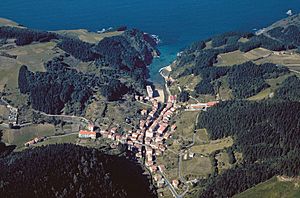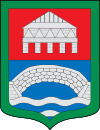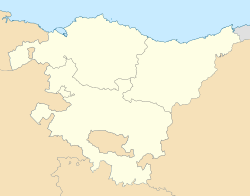Ea, Spain facts for kids
Quick facts for kids
Ea
|
|||
|---|---|---|---|
 |
|||
|
|||
| Country | Spain | ||
| Autonomous community | Basque Country | ||
| Province | Biscay | ||
| Comarca | Busturialdea | ||
| Area | |||
| • Total | 14.17 km2 (5.47 sq mi) | ||
| Elevation | 10 m (30 ft) | ||
| Population
(2018)
|
|||
| • Total | 831 | ||
| • Density | 58.65/km2 (151.89/sq mi) | ||
| Demonym(s) | Spanish: Earra Basque: Eatar |
||
| Time zone | UTC+1 (CET) | ||
| • Summer (DST) | UTC+2 (CEST) | ||
| Postal code |
48287
|
||
Ea (pronounced Ie in local Basque) is a small town in northern Spain. It's located in the Basque Country, a special region in Spain. Ea is part of the Biscay province. This town is also a municipality, which means it's a local government area.
The municipality of Ea has three main parts, called boroughs. These are Ea, Bedarona, and Natxitua. The borough named Ea is the largest and most populated. In 2018, about 831 people lived in the entire municipality.
Contents
Exploring Ea's Location and Landscape
Ea is a coastal town, meaning it's right by the sea. It sits about 50 kilometers (31 miles) northeast of Bilbao, a much larger city. The town is nestled at the end of a small estuary. An estuary is where a river meets the sea. This one breaks through the tall cliffs of the Bay of Biscay.
The Ea River and Its Bridges
The Ea river flows right through the town. You'll find three bridges crossing this river. The oldest one is often called the "Roman Bridge." However, it was actually built in the Middle Ages, not by the Romans. This historic bridge is even shown on the town's coat of arms!
Local Activities and Economy
Ea has a small fishing port. But fishing isn't the main activity here anymore. Most people in Ea work in agriculture (farming), silviculture (growing trees), or with cattle. You can see many farms spread out across the beautiful, typical Basque countryside.
A Glimpse into Ea's Past
Long ago, the area around Ea was mostly rural. It had two main villages, Natxitua and Bedarona. In the 1500s, fishermen from these villages decided to build a new, permanent settlement. They chose a spot at the end of the tiny Ea river estuary.
Over the next two centuries, this new settlement grew much more important. It became bigger than the two original villages. Eventually, a new municipality was formed. It brought together Natxitua and Bedarona, with Ea as its main town. Because of its past as two separate villages, Ea still has two main churches. One church is on each side of the river.
Getting Around Ea
If you need to travel within the town, there is a taxi service available.
Celebrating in Ea: Local Festivals
Ea loves to celebrate! The town has several fun festivals throughout the year.
- San Juan (Saint John the Baptist) is the first big celebration. It starts on the night of June 23rd and lasts until June 26th.
- On July 16th, the town celebrates The Virgin of Carmen. She is the patron saint of fishermen.
- San Ignacio (Saint Ignatius) takes place on July 31st. This festival is held in the Bedarona neighborhood.
- During the first weekend of August, there's a Gazte Eguna rock festival in Natxitua.
- On August 24th, everyone gathers for San Bartolome (Saint Bartholomew) day. This day includes a paella cooking championship. There are also traditional Basque sports and dancing at night.
- The last weekend of August marks an end-of-summer party.
Ea's Cultural Scene
Days of Poetry in Ea
Every year since 2003, Ea hosts a special poetry festival. It's called Eako Poesia Egunak, which means "Days of Poetry in Ea." This event lasts for three days in July. It was inspired by Gabriel Aresti, a famous Basque poet who used to visit Ea in the summer.
The festival is organized by a local cultural group called HEA. It features a mix of dance, poetry readings, concerts, and theater performances. The Days of Poetry has become a very important event in the Basque cultural calendar. For example, in 2014, the festival took place from July 15th to 17th.
Gallery
-
The estuary, looking towards the Bay of Biscay.
See also
 In Spanish: Ea (Vizcaya) para niños
In Spanish: Ea (Vizcaya) para niños








